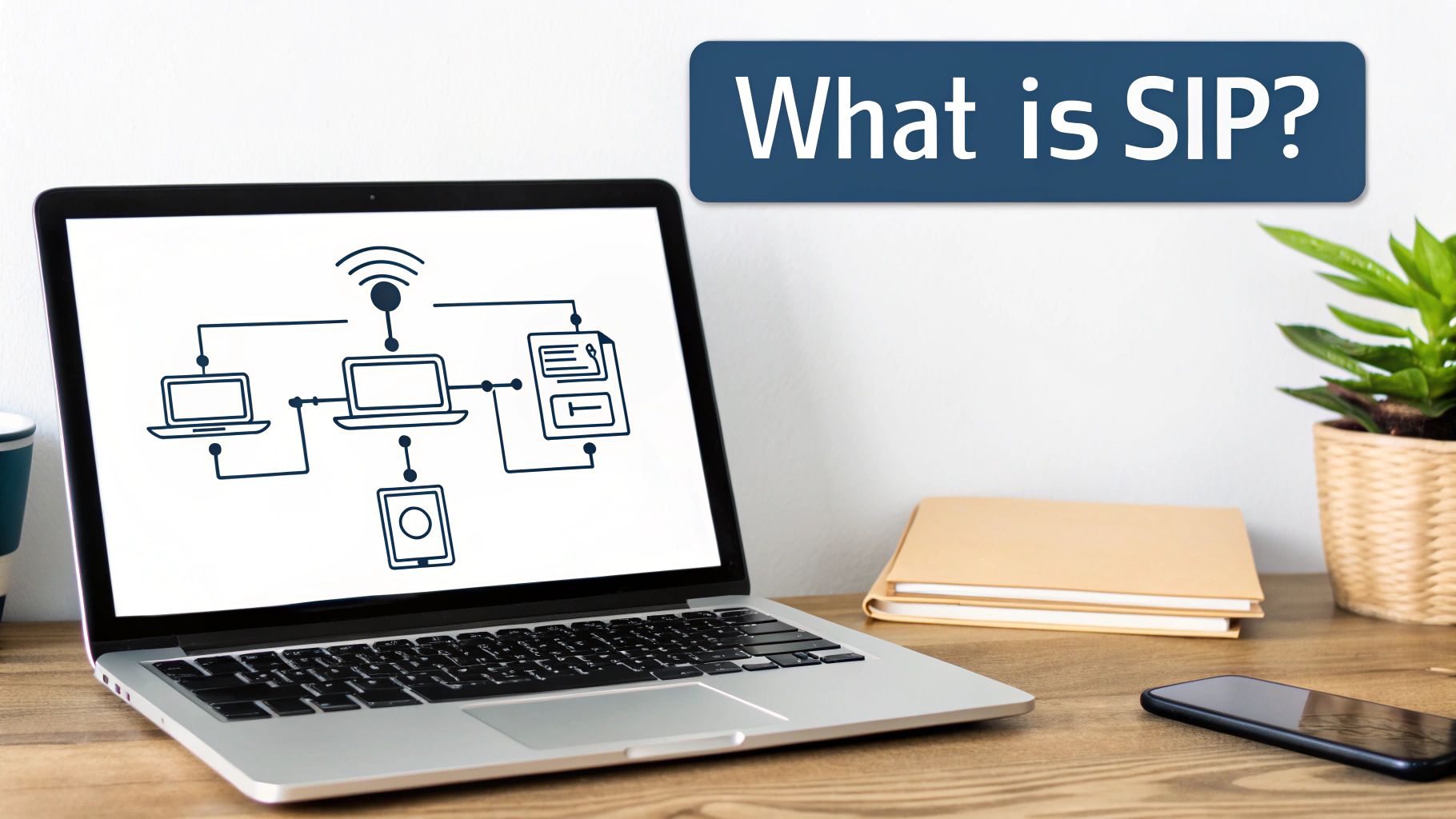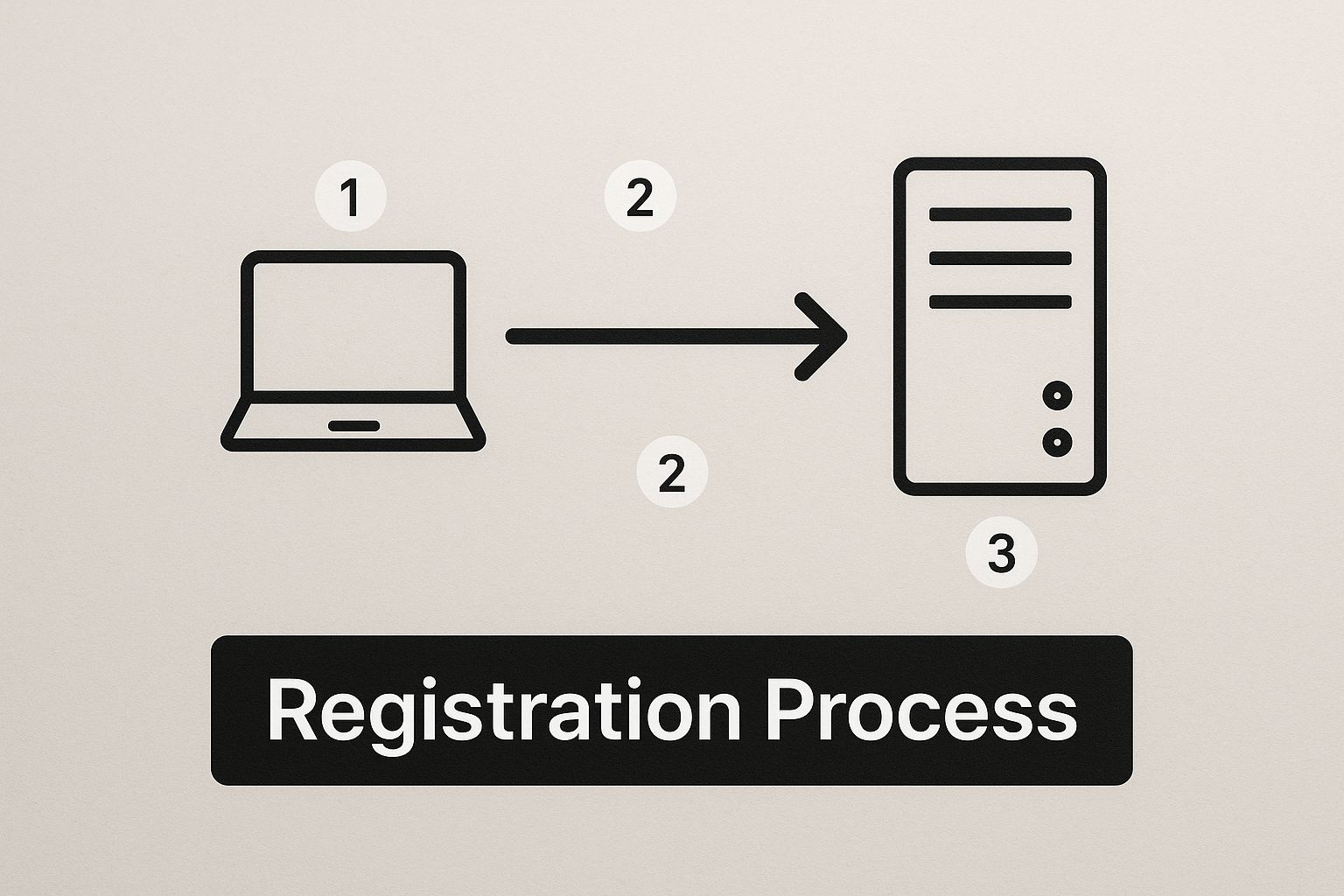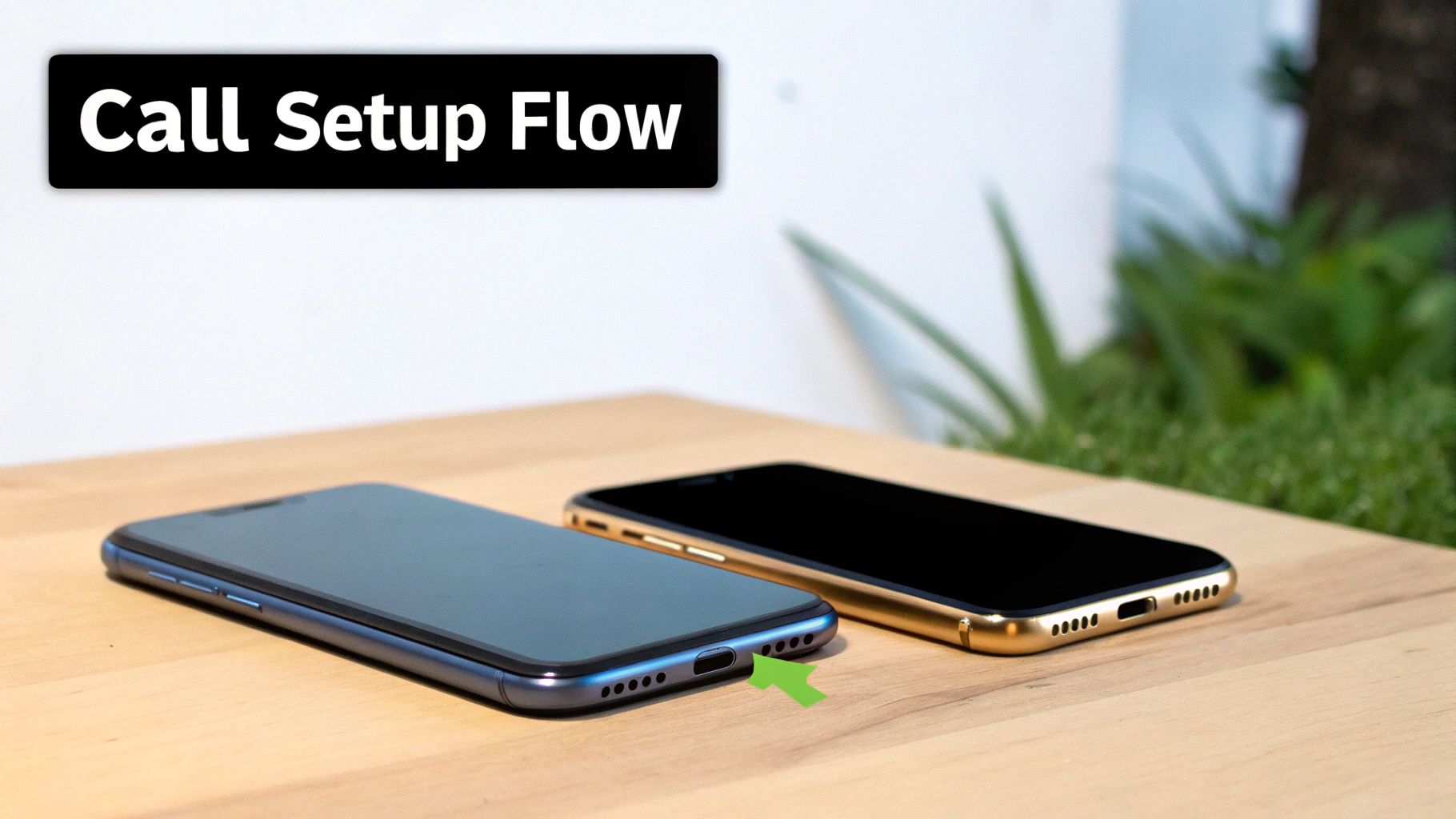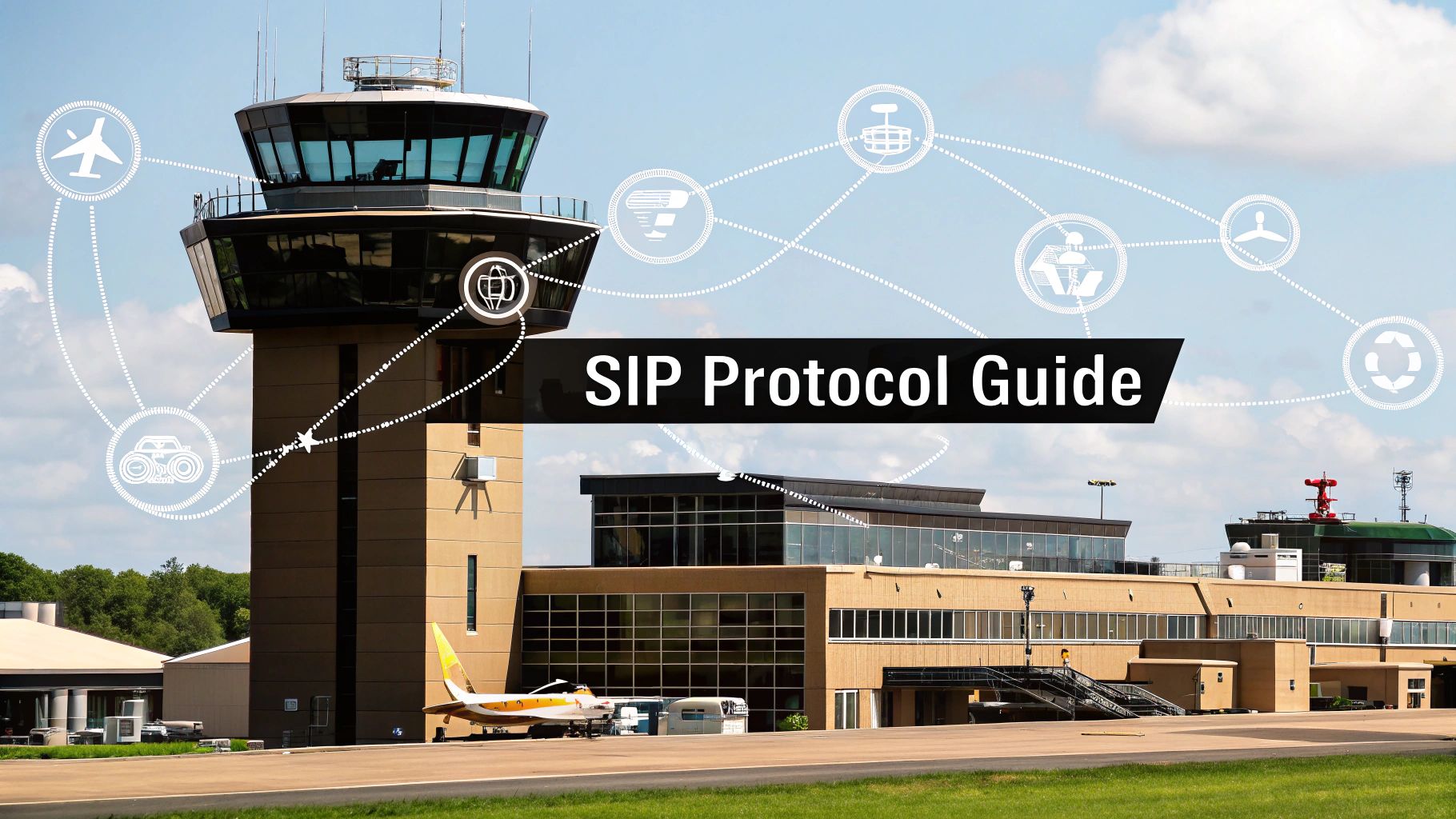Understanding SIP Session Initiation Protocol Fundamentals
Think of your business phone system as a busy airport. In this scenario, the SIP Session Initiation Protocol is the air traffic control system, skillfully managing every "flight"—whether it's a voice call, a video conference, or an instant message. Unlike old-fashioned phone systems that lock you into rigid and expensive hardware, SIP turns your communications into flexible, software-driven connections that move at the pace of your business. This is more than a simple update; it's a completely new way for businesses to connect and work together.
The main job of the SIP Session Initiation Protocol is to set up, change, and end these communication sessions over the internet. It's the digital handshake that occurs behind the scenes, establishing the rules for how different devices will communicate. For example, when you start a video call, SIP negotiates all the technical details, making sure your device and the recipient's agree on the right video codecs and are ready to send and receive data smoothly. This background negotiation is what enables modern unified communications. For a more detailed look, you can check out our guide on what Session Initiation Protocol is.
From Legacy to Leading-Edge
Businesses are steadily moving away from costly legacy systems like the Public Switched Telephone Network (PSTN) in favour of SIP-based solutions. The reasons are clear: scalability, cost savings, and unmatched flexibility. A small team can begin with a basic SIP setup and grow into a global enterprise system without needing to replace physical infrastructure. This adaptability is fuelling major market growth. In fact, the Middle East and Africa Session Initiation Protocol (SIP) Trunking Services market is expected to reach USD 1,551.30 million by 2029. This growth is driven by the protocol's ability to handle various applications like voice, video conferencing, and desktop sharing, which are vital for today's work environments. You can read more about this market growth research.
This diagram shows the fundamental components and how they interact within a SIP network.

The image highlights key elements such as the User Agent Client (UAC), User Agent Server (UAS), and various proxy and registrar servers. These components form the foundation of any communication network powered by SIP.
How It Unifies Communication
The true strength of the SIP Session Initiation Protocol is its capacity to merge different communication methods into one unified system. It gets rid of the complications of managing separate platforms for calls, video meetings, and messages. Here are some of the practical advantages:
- Unified Presence: SIP lets systems see a user's status (e.g., available, busy, on a call) across all their devices. This means a call can be smartly directed to an employee’s desk phone, computer softphone, or mobile app based on their current availability.
- Multimedia Sessions: It naturally supports mixing different media types in a single session. A voice call can be upgraded to a video call with screen sharing in just a few clicks, all without having to hang up and start a new connection.
- Device Independence: As a standardised protocol, SIP ensures that hardware and software from different manufacturers can work together. This gives you the freedom to pick the best tools for your business without being tied to one provider.
Breaking Down SIP Architecture Components That Actually Matter
To get a handle on how the SIP session initiation protocol operates, it helps to picture its architecture like a well-run restaurant kitchen. Every part has a specific job, yet they all work in concert to deliver the final product—a clear and dependable communication session. Instead of being a single, rigid system, SIP's strength lies in its modular design, where different elements handle specific tasks with great efficiency. This structure is what gives SIP the flexibility and interoperability that make it essential for modern business communications.
Let's unpack the core components that make every call, video conference, or message happen.
The Core Players: User Agents and Servers
At the centre of any SIP network are the endpoints and the servers that manage them. Each one plays a vital role in the communication journey, from kicking off the first "hello" to making sure the conversation gets to the right person.
-
User Agents (UAs): These are the endpoints of your communication. Think of them as the customer-facing staff in our restaurant analogy. A User Agent Client (UAC) is the part that starts a communication, much like a waiter taking an order. This could be your desk phone when you dial a number or your softphone app when you click "call." On the other hand, a User Agent Server (UAS) is the part that receives the communication request and responds, like the kitchen staff getting and fulfilling the order. Your phone acts as a UAS when it rings, showing an incoming call. Every SIP device, from a physical handset to a software client, functions as both a UAC and a UAS.
-
SIP Servers: These are the managers coordinating everything from behind the scenes. There are a few important types:
- Proxy Server: This is the clever maître d' of the network. It receives requests from a User Agent, figures out where they need to go, and forwards them to the next server or endpoint. It doesn't initiate calls itself but acts as a key middleman, routing traffic effectively.
- Registrar Server: This server functions as the dynamic reservation system. When a SIP device (like your office phone) powers on, it "registers" its current location (its IP address) with the Registrar. This process is like checking in for a dinner reservation. The Registrar stores this information, making sure the network always knows where to find you. This is crucial for mobility, as it lets calls follow you from your desk phone to your mobile app.
- Redirect Server: A less common but still significant player, the Redirect Server tells a User Agent Client how to directly contact the recipient, rather than forwarding the request itself. It provides the "directions" but doesn't make the trip for you.
This architectural overview from the original SIP standard, RFC 3261, visually shows these interactions.
The diagram illustrates how User Agents communicate through various servers, highlighting the protocol's client-server nature and the flow of requests and responses.
To better understand how these components function and impact a business's communication setup, let's compare them side-by-side.
Essential SIP Architecture Components Comparison
A detailed breakdown of core SIP components, their primary functions, and how they interact within the overall architecture
| Component | Primary Function | Key Features | Business Impact |
|---|---|---|---|
| User Agent Client (UAC) | Initiates SIP requests (e.g., placing a call). | – Sends INVITE messages. – Can be a hardware phone, softphone, or mobile app. |
Empowers users to start conversations, driving productivity and customer engagement. |
| User Agent Server (UAS) | Responds to SIP requests (e.g., answering a call). | – Receives INVITE messages. – Sends status responses (e.g., 200 OK). |
Ensures incoming communications are received, enabling responsiveness and availability. |
| Proxy Server | Routes SIP messages between User Agents. | – Forwards requests and responses. – Can perform authentication and policy enforcement. |
Acts as the traffic controller, ensuring reliable call routing and network security. |
| Registrar Server | Handles User Agent registration and location mapping. | – Maintains a database of user locations (IP addresses). – Enables "Find Me/Follow Me" functionality. |
Supports user mobility and remote work by allowing calls to reach users on any device, anywhere. |
| Redirect Server | Provides contact information for direct communication. | – Responds with a 3xx redirect message. – Does not stay in the call path. |
Can simplify call routing in specific network setups, though less common than a Proxy Server. |
This table shows that while each component has a distinct role, they are all interconnected. The User Agents are the active participants, while the servers provide the essential backend logic for routing and location services.
A critical element in many SIP-based VoIP deployments are systems like IP PBX solutions. These systems often combine the functionality of Proxy and Registrar servers, offering a central point of control for an organisation's entire phone system. This modularity is a key benefit, allowing businesses to select components from different vendors to build a tailored communication system that meets their specific needs and can expand with their growth.
How SIP Workflows Actually Work In Practice
Think of the SIP session initiation protocol as a swift, behind-the-scenes conversation happening between your devices. This digital dialogue, known as a workflow, is what ensures every call, video conference, or message is set up, managed, and ended correctly. It's a precise sequence of requests and responses that unfolds in milliseconds, but understanding it is key to seeing how modern communications work so reliably. The whole process kicks off with registration, a fundamental step that tells the network a device is online and ready to communicate.
This infographic simplifies the SIP registration process, showing how a user's device communicates with a server to announce its presence on the network.

This visual shows the crucial first handshake where a device shares its credentials and location (its IP address) with a registrar server, making it possible for others to find and connect with it for incoming sessions.
The Anatomy of a Basic SIP Call
To see the protocol in action, let’s walk through the steps of a simple two-party call. Imagine Alice wants to call Bob.
-
The Invitation (INVITE): Alice's phone, acting as a User Agent Client, sends an INVITE message to her proxy server. This is like knocking on Bob's digital door. The message holds all the important details for the call, such as Alice's and Bob's SIP addresses and the media types she can handle (like specific audio codecs), which are defined using the Session Description Protocol (SDP).
-
Locating the Recipient: Alice's proxy server passes the INVITE to the registrar server to find Bob's current location (his IP address). Once located, the proxy forwards the INVITE message to Bob's device.
-
The Ringing Response (180 Ringing): When Bob’s phone gets the INVITE, it begins to ring. To let Alice know the call is going through, Bob's phone (now a User Agent Server) sends back a 180 Ringing response. This is the signal that triggers the ringing tone Alice hears on her end.
-
The Agreement (200 OK): Bob answers the call. His device sends a 200 OK message, confirming he has accepted and agrees to the technical terms (the media parameters) from the initial INVITE. The connection is now primed and ready.
-
The Acknowledgement (ACK): To finalise the setup, Alice’s phone sends one last ACK (Acknowledgement) message to Bob's phone. This completes the "three-way handshake," and the session is officially live. From this moment, their voices, converted into data packets, start flowing directly between them using the Real-time Transport Protocol (RTP).
Ending the Conversation Gracefully
When either Alice or Bob decides to hang up, their device sends a BYE message to the other. In response, the other device sends back a 200 OK to confirm the session has ended. This structured conclusion ensures the call is terminated cleanly, freeing up communication resources efficiently.
This efficiency is a major reason why the SIP Trunking market is expanding in regions like the Middle East and Africa, offering significant cost savings and scalability over older phone systems. By centralising the management of communications, businesses can substantially improve their operational performance. You can read more about these findings on the SIP Trunking service market.
Real-World SIP Applications Across Industries
While understanding the technical side of the SIP session initiation protocol is important, its real power becomes clear when we see it solving actual business problems. This protocol isn't just a modern substitute for old telephone lines; it’s a flexible foundation for creating specialised communication systems. From healthcare to finance, organisations are using SIP to build more efficient, connected, and responsive operations.

This adoption is happening globally. The growth of SIP Trunking in the Middle East and Africa, for instance, is a testament to its broad appeal across sectors like finance, healthcare, and education. These industries are upgrading their communication infrastructure with SIP, as detailed in reports about regional SIP adoption on openpr.com. This trend shows that SIP's main advantages are universally valuable, no matter the industry.
Transforming Sector-Specific Communications
The adaptability of SIP allows it to meet the distinct needs of different industries. Businesses often access this power through comprehensive VoIP Solutions, which package the protocol's capabilities into ready-to-use services. Let’s look at how specific sectors are benefiting:
-
Healthcare: Medical providers depend on SIP for secure telehealth services, enabling video consultations that connect doctors with patients anywhere in the world. This is especially vital for reaching remote or underserved communities. SIP also ensures dependable communication within large hospitals, making sure urgent messages between departments are delivered without delay.
-
Finance: In the heavily regulated financial sector, every conversation needs to be secure and traceable. Financial firms use SIP-based systems for compliance-focused communications, such as recording trading calls and conducting secure client meetings. The protocol's support for strong encryption, like TLS for signalling and SRTP for media, is critical for safeguarding sensitive financial information.
-
Education: Schools and universities use SIP to build powerful distance learning platforms. It facilitates virtual classrooms with high-quality video, interactive features, and breakout rooms, creating an engaging learning environment. This technology helps educational institutions extend their programmes to a global student audience.
-
Retail and Manufacturing: A retail company with many locations can use a single SIP system for smooth communication between its head office, warehouses, and stores. Similarly, manufacturing businesses use SIP to manage complex supply chains, connecting teams across countries to coordinate logistics and production schedules effectively.
To better illustrate how different sectors gain from SIP, the table below provides a detailed breakdown of use cases, benefits, and implementation factors.
Table: SIP Implementation Benefits Across Industries
Comprehensive analysis of how different industries benefit from SIP implementation, including specific use cases and measurable outcomes
| Industry | Primary Use Case | Key Benefits | Cost Savings | Implementation Complexity |
|---|---|---|---|---|
| Healthcare | Telehealth & Internal Communications | High-quality, secure video consultations; reliable internal alert and paging systems; improved patient outreach. | 30-50% reduction in traditional telephony costs. | High (Requires HIPAA compliance, EMR integration, and high-security standards). |
| Finance | Secure & Compliant Trading | Encrypted call recording for audit trails; secure client communication channels; enhanced data protection. | 25-40% by consolidating communication lines. | High (Needs strict compliance with regulations like MiFID II, involves complex network security). |
| Education | Distance Learning Platforms | Interactive multimedia classroom experiences; scalability for thousands of users; global student reach. | 40-60% on long-distance and inter-campus calls. | Moderate (Integration with Learning Management Systems (LMS) can be complex but is otherwise straightforward). |
| Retail | Multi-Site Unified Communications | Centralised management of all store communications; low-cost inter-branch calling; improved customer service response. | Up to 70% on inter-store call charges. | Low to Moderate (Depends on the scale of deployment and existing POS/CRM system integration). |
| Manufacturing | Supply Chain Coordination | Real-time communication across production sites; integration with IoT devices for alerts; streamlined logistics management. | 35-55% on international and inter-site communication. | Moderate (Requires integration with ERP and supply chain management software). |
As the table shows, the benefits are clear and measurable. From significant cost reductions to enhanced operational capabilities, SIP provides a tangible return on investment.
These examples prove that the SIP session initiation protocol is more than a technical standard—it is a tool for business growth. By offering a flexible, scalable, and secure framework for communication, it helps organisations in every industry to address their specific challenges, boost efficiency, and create better ways to connect with customers and colleagues.
Securing Your SIP Infrastructure The Right Way
While a SIP session initiation protocol system brings remarkable flexibility, its open nature requires a serious security strategy. Relying on just a firewall is like locking your front door but leaving all the windows open. Because SIP operates over public internet networks, it faces security challenges that old-school phone systems never did. A proactive, multi-layered approach is crucial to shield your communications from bad actors.
This layered security model functions like a modern building's security system, combining different measures to form a strong defence. The aim is to protect against common threats that can interrupt services, violate privacy, and cause major financial damage. With the correct security in place, you can use SIP confidently without exposing your organisation to unnecessary risk.
Common Threats and Effective Countermeasures
Protecting your SIP infrastructure starts with knowing the specific threats you're up against. Hackers often target VoIP systems as they can be profitable entry points for fraud or disruption. A key part of SIP security is defending against DDoS attacks, which can overload your system and stop communications completely.
Here are some of the most common threats and the best ways to fight them:
-
Toll Fraud: This is one of the most frequent and expensive attacks. Attackers get unauthorised access to your PBX and make a high volume of costly international calls, leaving you with a huge bill.
- Countermeasure: Use strong, unique passwords for all SIP endpoints. Enforce strict calling rules that block calls to high-risk international numbers unless absolutely necessary.
-
Eavesdropping: Unencrypted calls are like having a conversation in a crowded room—anyone can listen in. Attackers can capture call data to steal sensitive business or personal information.
- Countermeasure: The answer is encryption. Use Transport Layer Security (TLS) to encrypt signalling messages (the call setup details) and Secure Real-time Transport Protocol (SRTP) to encrypt the actual media stream (the voice or video).
-
SIP Flooding (Denial-of-Service): In this attack, a system is hit with a flood of fake INVITE requests. This overwhelms the server and stops it from handling real calls.
- Countermeasure: Use a Session Border Controller (SBC). An SBC acts like a security guard for your network, checking all incoming and outgoing SIP traffic, filtering out malicious requests, and protecting your internal servers.
Building a Fortified SIP Environment
Beyond tackling specific threats, a complete security plan involves smart network design and constant watchfulness. Thinking about how your communication systems link together, such as with an IP SIP trunk, is a vital part of this planning. A well-protected environment mixes technology with best practices.
Think about putting these fundamental security strategies into action:
| Security Strategy | Description | Key Benefit |
|---|---|---|
| Network Segmentation | Place your voice traffic on a separate Virtual LAN (VLAN). | Stops a security breach in your data network from easily spreading to your essential communication systems. |
| Intrusion Detection/Prevention | Use systems (IDS/IPS) that check network traffic for suspicious activity and known attack patterns. | Gives real-time alerts and can automatically block potential threats before they do any harm. |
| Regular Security Audits | Periodically check your configurations, access logs, and security policies to find and fix any new vulnerabilities. | Makes sure your security measures stay effective and adapt to new threats over time. |
By combining strong encryption, solid authentication, and intelligent network architecture, you can build a SIP infrastructure that is both powerful and secure.
Your Step-By-Step SIP Implementation Roadmap
Successfully putting the SIP session initiation protocol into practice isn't like flicking a switch; it's more like constructing a building. It requires a detailed plan that considers your organisation's specific needs, current infrastructure, and future goals. A strong implementation begins with a thorough assessment and careful planning, followed by choosing components that fit together perfectly. Without a clear roadmap, even the most promising projects can run into major problems.
This guide simplifies the deployment into manageable phases, helping you move from the initial idea to a fully working system your team can count on. By using a structured approach, you can sidestep common issues and make sure your new communication system performs well from the start.
Phase 1: Assessment and Planning
Before you select a single piece of hardware or software, you must first understand your starting point. This initial phase is all about discovery and creating a blueprint for your project.
- Network Readiness Assessment: Think of your network as the highway for all your SIP traffic. A complete assessment is essential. You need to analyse your current bandwidth, latency, and packet loss to confirm it can support real-time voice and video. A network that already struggles with data will certainly fail with voice, leading to poor call quality and frustrated users.
- Capacity Planning: How many simultaneous calls does your business need to handle right now? What about in two years? Capacity planning involves forecasting your usage to ensure the system you build can grow with you. Not having enough capacity results in blocked calls during busy hours, while having too much means you are paying for resources you don't use.
- Defining Requirements: Create a detailed document of what the system must do. This should include key features (like call recording, auto-attendant, or video conferencing), how it will connect with other tools (such as CRM software), and any security or compliance rules specific to your industry.
Phase 2: Pilot Testing and Gradual Rollout
With your plan in place, it's time to test your ideas in a controlled setting. A pilot programme acts as your safety net, letting you find and fix problems before they affect the entire organisation.
- Select a Pilot Group: Pick a small, diverse group of users from different departments. Their feedback will be incredibly useful for fine-tuning the system.
- Deploy and Train: Set up the SIP system for this pilot group and give them complete training. This is your opportunity to test your training materials and see how quickly users adopt the new tools.
- Gather Feedback and Iterate: Actively ask for feedback on call quality, how easy the features are to use, and the overall experience. Use this information to make necessary adjustments to your setup and plan. For organisations in the UAE, trying out options like an Etisalat SIP Trunk during this stage can help confirm provider performance.
- Phased Rollout: After a successful pilot, start deploying the system department by department or location by location. This staggered method reduces disruption and lets your IT team give focused support to each group as they make the switch.
Phase 3: Change Management and Optimisation
Technology is only half the puzzle; getting people to use it is the other. Good change management is vital for user adoption and achieving long-term success.
- Communicate Clearly: Explain the "why" behind the new system. Emphasise the benefits for both employees and the company as a whole.
- Provide Ongoing Training: Offer a variety of training resources, from live workshops to on-demand videos, to suit different learning preferences.
- Monitor and Optimise: Your job isn't done once the system is live. Continuously monitor performance, call quality data, and user feedback. Use this information to fine-tune configurations, improve call routing, and make sure the system keeps meeting your business needs as they change.
A systematic implementation ensures your investment in the SIP session initiation protocol pays off, turning your business communications into a valuable asset.
Ready to build a communication system that grows with your business? Cloud Move provides expert consultancy and customised deployments for organisations of all sizes. Request your free demo today!




